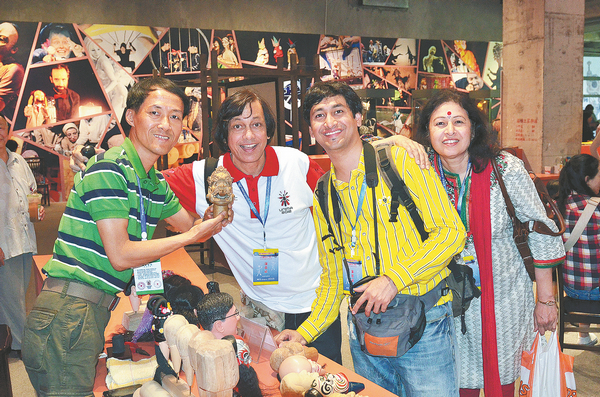Master of puppets

Lin exchanges puppet making techniques with artisans from abroad. CHINA DAILY
Intricate artistry, a vivid imagination and great skill breathe life into wooden figurines that have delighted audiences for millennia, Yang Feiyue reports.
The rhythmic sound of wood being drilled often piques the curiosity of visitors when they step into the Quanzhou Puppetry Theater. As they seek the origin of the sound, they will find Lin Congpeng toiling away at his work bench under a reading lamp.
As the man, in his 50s, beavers away, blocks of wood are brought to life as they transform into puppets of various, vivid shapes and sizes.
Over the past few months, Lin has been busy creating a series of puppets for a major new 30-hour show.
"It is as big a production as nearly 20 conventional plays and requires about 100 puppet heads," Lin says.
To ensure timely delivery, Lin has put in many extra hours.
The process for each character includes rough shaping, forming, coarse carving, intricate detailing, paper mounting, color application, facial sculpting and wax coating to create a puppet.
Quanzhou puppetry was named a national intangible cultural heritage in 2006, and, in 2012, the Quanzhou Puppetry Theater was added to the Register of Good Safeguarding Practices by UNESCO.
Lin has committed himself to the trade for more than 40 years. His works feature in the play Flaming Mountain, which was based on one of the four great classical Chinese novels, Journey to the West, by Wu Cheng'en of the Ming Dynasty (1368-1644).
In 2009, Lin was named a national inheritor of the intangible cultural heritage.
Lin joined the theater when he was 16, and he has carved about 1,000 puppets. Some of his works were featured during the 2008 Beijing Summer Olympics and the 2010 World Expo in Shanghai, while some have found their way into museum collections across the country.
As one of the oldest and rarest forms of puppet theater in China, the Quanzhou puppet show enjoys a history of more than 2,000 years.
It is believed to have originated as a communication medium between humans and gods. As a result, it has been imbued with religious connotations since its creation, says Wang Jingxian, art supervisor with the Quanzhou Puppetry Theater.
The show has evolved into an indispensable part of local life in Quanzhou, where it is customary to stage puppet shows at weddings, birthdays and the openings of buildings.
"The entire system of puppetry, including performance, head crafting, and traditional music, has been passed down for centuries," Wang says.
Crafting a small puppet head retains the same application of painting, carving and polychrome sculpture techniques as the Tang (618-907) and Song (960-1279) dynasties, and, as such, holds a significant place in the history of Chinese folk art, experts say.
A Quanzhou puppet show generally uses marionettes that are usually about 70 centimeters tall, consisting of a head, belly, limbs, strings and an operation board that is held at a height of about one or two meters to control the figure. The puppet head is carved from camphor, linden or willow wood and can exhibit a variety of expressions.
"It can take up to a decade for a young actor to learn how to manipulate a puppet and perform onstage," Wang says, adding that local puppetry is capable of simulating many human movements, thanks to the intricate craftsmanship.
"They can flawlessly mimic even the most subtle human actions, making many audiences feel like they are watching real people," Wang says.
Lin was born into a family of craftsmen. His grandfather was a renowned craftsman of silver jewelry and his father was a traditional paper-cut artist.
At the age of 12, Lin started to learn puppet sculpting with his older brother, who studied the art at the Quanzhou Puppetry Theater.
Initially, he struggled to handle the carving knife alone.
"I didn't have enough strength to push it properly and often borrowed strength from the shoulders, which caused injury," he recalls.
It took him years just to get the hang of holding the knife properly.
Now, deftly wielding the knife, he whittles the wood as if he were sculpting clay.
The ideal material for puppets is lightweight, moisture and termite-resistant camphor wood roots.
"The wood grain is interlocking, preventing deformation and cracks," he explains.
Some of his works have been in use for decades and are still as good as new.
"With proper care, a puppet head can last for a hundred years," he says.
The process of making puppet heads is different from wood carving, which usually involves fixing the wood and chiseling it bit by bit.
"But making puppet heads involves shaving the wood from start to finish, with the image and profile of the character already in mind," Lin says.
The challenge lies in achieving the desired shape.
"Every stroke of the knife needs to be slow and precise, as it is an art of meticulous reduction. If one eye is carved crooked, the entire work is ruined," he says.
In 1978, Lin signed himself up for a puppetry program at a local art school, where he not only continued to hone his skills systematically, but also learned about performance of the art.
"It has gone a long way toward fueling my passion for making puppets, because I was able to better understand the characters in those shows," he says.
"Wood is lifeless, but we must imbue the puppets we carve with vitality and embody the characters in the play," Lin says, adding that people in his trade must also have a deep understanding of the characters' personalities before they can apply their expertise and give the puppets the necessary vividness and realism.
Speaking from his own experiences, Lin says he will give full play to his own imagination based on the scripts and come up with a clay prototype.
Adjustments will be made according to feedback from scriptwriters and directors, before the wood sculpting begins.
After completing the basic form of the puppet, a mechanical mechanism is installed.
For example, the puppet's eyes can be made to rotate and its mouth will open and close.
Makeup will then be applied, with eyebrows and eyes carefully outlined.
"Only then can it appear natural, lively and animated," Lin says.
As a puppet head sculptor, Lin has not only inherited the traditional craftsmanship, but also constantly innovates to meet the aesthetic needs of modern audiences.
For example, when he was asked to create a puppet character of the Italian explorer and merchant Marco Polo, who lived during the 13th and 14th centuries, for a concert at the National Centre for the Performing Arts in 2008, he applied a mixture of granular adhesive material to attach a bushy beard to the puppet's chin.
"Traditional puppets usually only have soft hair, which didn't quite match the image of a Westerner," he explains.
Over the years, he has often walked into the theaters to observe the audience's reactions to different puppets, in order to keep track of the subtle changes of public taste for the traditional show.
Lin has also applied a spray gun in the painting process.
In the past, artists had to carry out the process more than a dozen times to paint the puppets with mineral pigments.
"Now, we can just use a brush to lay the foundation and use a spray gun to apply paint, allowing it to dry faster," he says.
"The colors are brighter, smoother and more delicate than in the past, and they are also more in line with modern stage aesthetics."
As he is about to retire, Lin says he hopes that more young people will join the theater to help carry forward the traditional craft and breathe new life into it.
"Each puppet is like a living being to me," Lin says.
"The change of their facial features reflects different personalities, which makes the carving process a dialogue with life itself."




